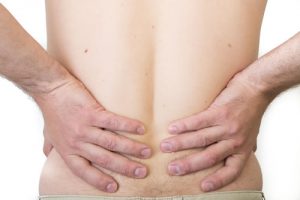Osteopathy and Low Back Pain
Osteopathy is a medical healthcare profession that utilises a patient focused, physical approach to restoring, maintaining and promoting physical and psychosocial well being. Osteopathy focuses on a whole body approach and applies a variety of techniques to free up joint restrictions, increase spinal and soft tissue flexibility, improve circulation and provide advice and exercises relevant to the individual person and their presenting condition. (The British Osteopathic Association).

Low back pain is reported in approximately 80% of people at some time in their life. The low back or lumbar spine is under constant stress and strain from the office worker and commuter who sits long hours, to the increased demands from an athlete or busy pregnant mum looking after her small children.
The structure of the lumbar spine is comprised of 5 lumbar vertebrae and in between each lies a disc comprised of an inner jelly nucleus pulposus and an outer layer of fibres called the annulus fibrosus. These discs act as shock absorbers through the spine and work alongside a complex network of muscles, ligaments, nerves, lymphatics and blood vessels. The lumbar spine has a natural curve in its lower region called the lumbar lordosis. This is commonly an area for low back pain due to the angle and increased stress placed on this region.
Low back pain can be classified as acute lasting less than 6 weeks or chronic lasting weeks, months and even years. The onset of low back pain can be acute due to lifting something heavy or bending and feeling an immediate sharp pain in the low back, or gradual for no apparent reason. Change in activites can also aggravate the low back such as a long drive and sitting for increased amounts of time to painting the bathroom ceiling over a weekend.
There are many different causes of low back pain from acute muscle spasms, disc anomalies or nerve pain where the patient may experience a pain in the leg or foot but the origin is in the lumbar spine. Osteoarthritis commonly affects the hips, knees and lumbar spine region causing pain and stiffness due to decreased ranges of movement from the vertebrae and muscles. It is also important to remember that some back pain is not due to a mechanical cause and can be from a visceral referral such as the kidneys, bladder or abdominal region.

Your osteopath will examine you and take a full medical history and treat if appropriate. We also have strong links with local GPs and if we feel further tests or investigations are required can refer the patient for blood tests, x-rays and MRI scans.
A healthy low back can be maintained with a combination of exercise, postural advice and being aware of individual limitations.
If you would like any advice or further information regarding low back pain please contact us at the Osteopathic Centre.




